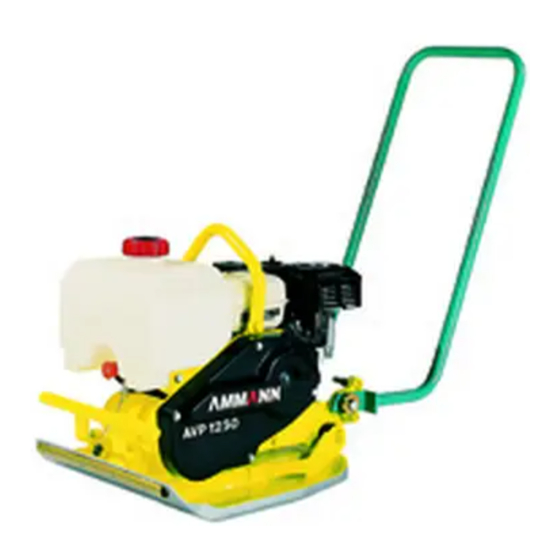
Summarization of Contents
1. Safety regulations
Normal Use
Defines the intended application for compaction in civil engineering and road construction.
Improper Use
Highlights hazards from incorrect operation, unauthorized personnel, or unintended purposes.
Who is allowed to operate the machine?
Specifies that only qualified, instructed, and authorized persons over 18 may operate the machine.
Conversions and modifications to the machine
Warns against unauthorized modifications and conversions due to safety risks and liability.
Safety information in the operating and maintenance instructions
Explains the meaning of symbols like Important, Attention, and Danger used in the manual.
Starting the machine
Details precautions and steps for safely starting the engine and the machine.
Machine control
Covers safe operation of machine controls and general machine handling.
2. Technical Data
1. Dimensions
Provides physical measurements like length, height, and working width for different models.
2. Weights
Lists the operating weight for each vibration plate model.
3. Drive
Details motor type, power, cooling, fuel capacity, consumption, and drive system.
4. Speed
Specifies the maximum working speed for the vibration plates.
5. Vibration
Lists vibration force and frequency for the machines.
6. Working surface
Indicates the effective working surface area for compaction.
7. Spec. surface pressure
Shows the specific surface pressure exerted by the plates.
8. Optional equipment
Lists available optional accessories that can be fitted to the machines.
9. Noise and Vibration data
Presents noise emission and hand-arm vibration values according to EC directives.
3. Operation
3.1 Description
Explains the vibration plate's function, movement, components, and provides an equipment overview.
3.2 Before operation
Details essential pre-operation checks, safety observations, and equipment inspection steps.
3.3 Engine operation (Honda)
Provides procedures for starting and switching off the Honda engine, including choke and oil warning.
3.4 Engine operation (Hatz)
Details procedures for starting and switching off the Hatz engine, including rope pull and troubleshooting.
3.5 Operation
Guides on operating the vibration plate, steering, speed control, and clutch engagement.
4. Transportation
4.1 Bogie
Instructions for using the bogie to transport the plate over short distances.
4.0 Loading and transportation
Safety precautions and procedures for loading, securing, and transporting the machine.
5. Maintenance
5.1 General notes
General advice on careful maintenance, safety, cleaning, and environmentally friendly disposal.
5.2 Maintenance schedule
Schedule of maintenance tasks for Honda and Hatz engines based on operating hours.
5.3 Lubrication schedule
Details lubrication points, quantities, intervals, and lubricant types for engine and exciter.
5.4 Alternative lubricant schedule
Lists alternative lubricant options for various machine components.
5.5 Maintenance work (Honda-engine)
Daily maintenance tasks for Honda engine: fuel, oil checks, and air filter cleaning.
5.6 Maintenance work (HATZ-engine)
Daily maintenance tasks for Hatz engine: fuel, oil checks, air intake, and dry air filter cleaning.
5.7 Maintenance work on the machine
Daily machine cleaning, torque checks, screw connections, rubber buffers, and V-belt checks.
5.7.6 Exciter: Oil level / Oil change
Procedures for checking and changing the oil in the exciter unit.










Need help?
Do you have a question about the AVP 1850 H and is the answer not in the manual?
Questions and answers